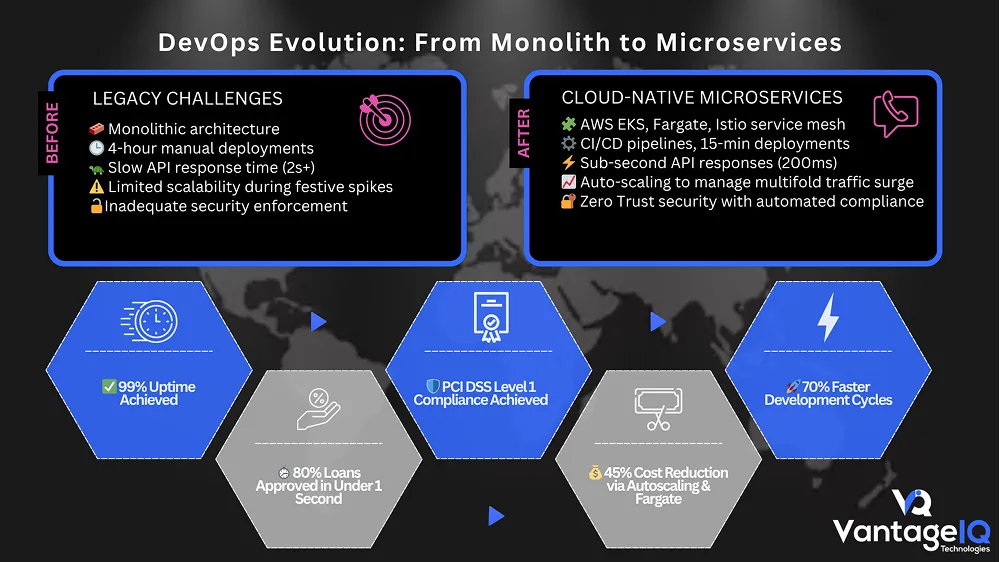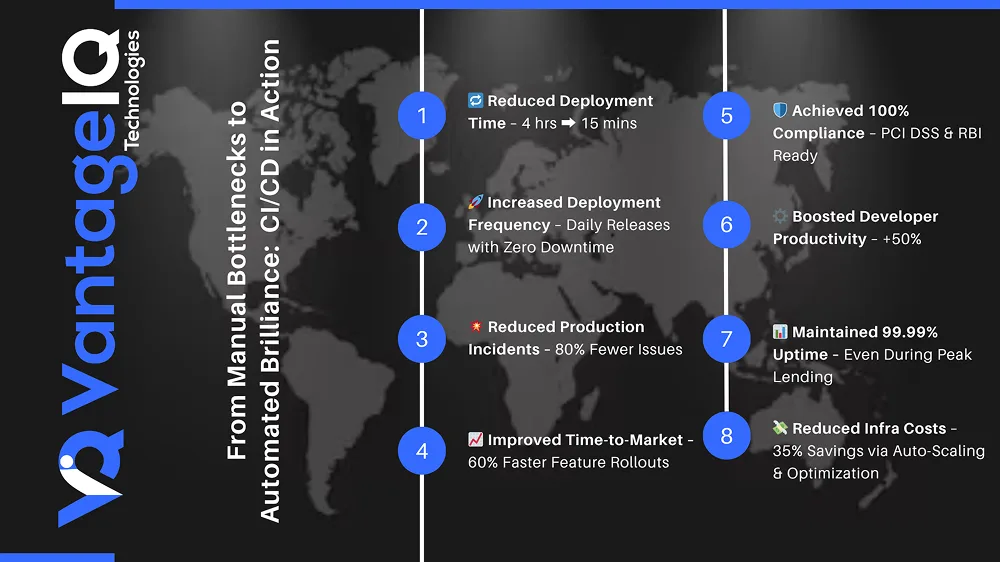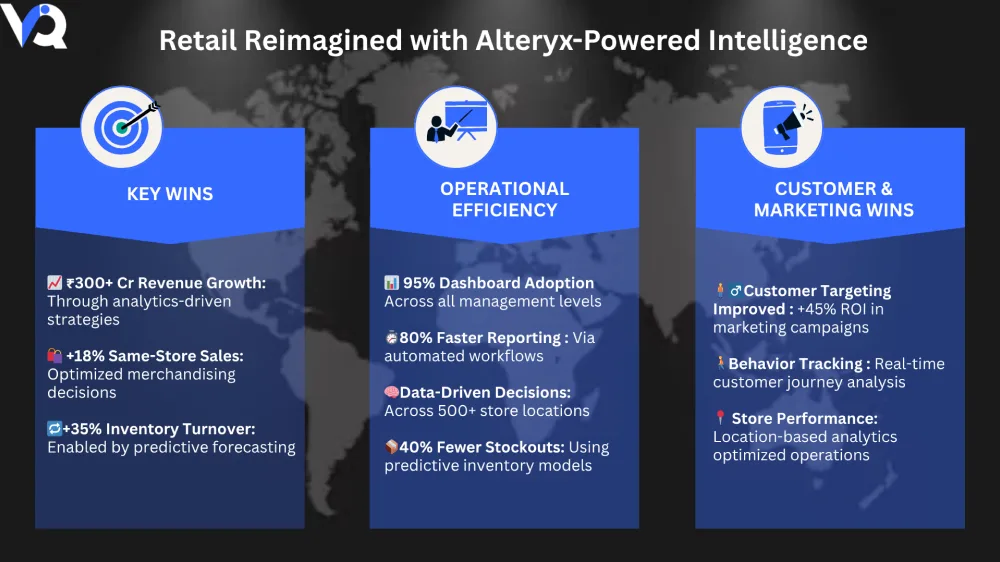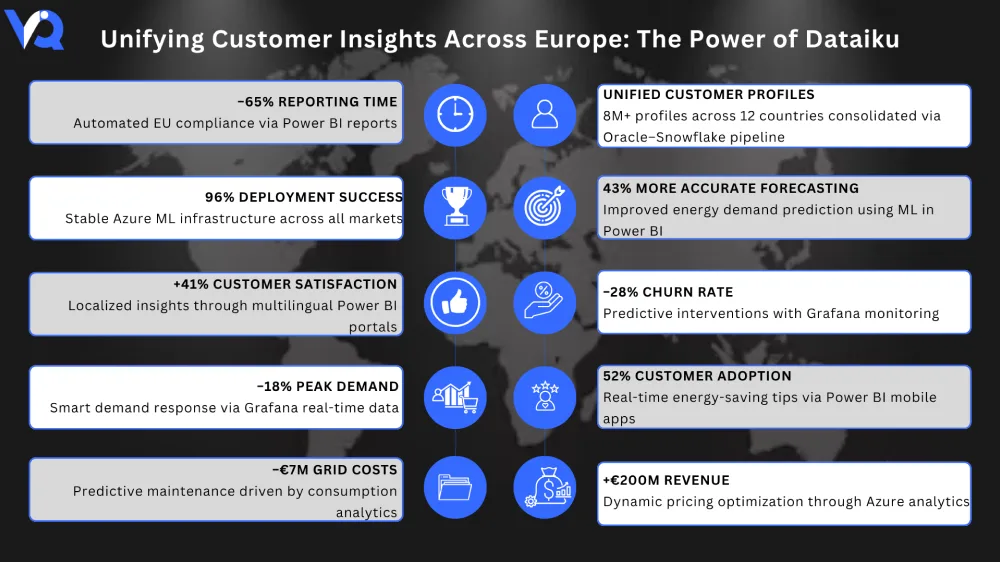Cloud-Native Microservices Architecture and Container Orchestration
Client: Major Digital Lending Platform (5M+ customers, ₹25,000+ crore loan book)
- Home
- »
- Case Study
- »
- Cloud-Native Microservices Architecture and Container Orchestration
Challenge
The lending platform’s monolithic architecture was limiting scalability and deployment flexibility. With rapid business growth, seasonal traffic spikes (300% increase during festival seasons), and the need to integrate 15+ external services (CIBIL, Experian, PAN verification, bank statement analysis, GST data), the platform required a cloud-native microservices architecture that could handle 50,000+ loan applications daily while maintaining sub-second response times and regulatory compliance.

Our Solution:
VantageIQ architected and implemented a comprehensive cloud-native microservices platform using AWS container services:
Technology Stack:
- Amazon EKS (Elastic Kubernetes Service) for container orchestration
- AWS Fargate for serverless container deployment
- Amazon ECR for container image registry and vulnerability scanning
- Docker for application containerization
- Istio Service Mesh for microservices communication and security
- Amazon RDS Aurora for database services with multi-AZ deployment
- Amazon ElastiCache (Redis) for high-performance caching
- Amazon API Gateway for API management and throttling
- AWS Application Load Balancer for traffic distribution
- Amazon CloudFront for global content delivery
- AWS Lambda for event-driven serverless functions
- Amazon SQS/SNS for asynchronous messaging
Core Business Services:
- Customer Management Service: User registration, KYC, and profile management
- Loan Origination Service: Application processing and workflow management
- Credit Scoring Service: Real-time credit assessment and risk evaluation
- Document Processing Service: OCR, verification, and compliance checking
- Payment Processing Service: EMI collection and payment gateway integration
- Notification Service: Multi-channel communication (SMS, email, push notifications)
- Analytics Service: Real-time business intelligence and reporting
- Compliance Service: Regulatory reporting and audit trail management
Integration Services:
- Credit Bureau Gateway: CIBIL, Experian, Equifax integration with circuit breakers
- Government API Gateway: PAN, Aadhaar, GST verification services
- Banking Integration Service: Account verification and statement analysis
- Third-Party Data Service: Alternative data sources and enrichment
- Identity Verification Service: Multi-factor authentication and fraud detection
- Geo-Location Service: Address verification and risk assessment
Platform Services:
- Authentication & Authorization: OAuth 2.0/JWT with role-based access control
- Configuration Management: Centralized configuration with AWS Systems Manager
- Logging & Monitoring: Centralized logging with ELK stack and AWS CloudWatch
- Message Queue Service: Event-driven architecture with Amazon SQS/SNS
- File Storage Service: Secure document storage with Amazon S3 and encryption
- Caching Service: Multi-tier caching with Redis and CloudFront
Container Orchestration Features:
Kubernetes Configuration:
- Horizontal Pod Autoscaler: Automatic scaling based on CPU, memory, and custom metrics
- Vertical Pod Autoscaler: Right-sizing of container resources for cost optimization
- Cluster Autoscaler: Node scaling based on pod scheduling requirements
- Pod Disruption Budgets: Ensuring high availability during cluster maintenance
- Resource Quotas: Namespace-based resource allocation and limits
- Network Policies: Microsegmentation and security isolation between services
Service Mesh Implementation:
- Istio Sidecar Proxy: Automatic service-to-service communication encryption
- Traffic Management: Canary deployments, A/B testing, and blue-green deployments
- Security Policies: mTLS authentication and authorization between microservices
- Observability: Distributed tracing, metrics collection, and service mapping
- Circuit Breaker: Automatic failure detection and recovery mechanisms
- Rate Limiting: Per-service and per-user rate limiting for API protection
- Advanced Cloud-Native Features:
Event-Driven Architecture:
- Event Sourcing: Complete audit trail of all business events and state changes
- CQRS Pattern: Separate read and write models for optimal performance
- Saga Pattern: Distributed transaction management across microservices
- Event Streaming: Real-time event processing with Apache Kafka on Amazon MSK
- Dead Letter Queues: Handling and retry mechanisms for failed message processing
- Event Schema Registry: Centralized schema management for event evolution
Data Management:
- Database per Service: Microservice-specific databases for data isolation
- Data Synchronization: Event-driven data consistency across services
- Multi-Master Replication: Aurora Global Database for disaster recovery
- Read Replicas: Separate read workloads for improved performance
- Data Partitioning: Horizontal scaling for high-volume customer data
- Backup and Recovery: Automated point-in-time recovery with cross-region replication
Security and Compliance:
- Zero Trust Architecture: No implicit trust between microservices
- Pod Security Standards: Kubernetes security policies for container isolation
- Secrets Management: AWS Secrets Manager integration with automatic rotation
- Image Scanning: Continuous vulnerability scanning of container images
- Runtime Security: Falco-based runtime threat detection and response
- Compliance Automation: Automated PCI DSS and SOC 2 compliance validation
Performance Optimization:
- Connection Pooling: Optimized database connections across microservices
- Caching Strategy: Multi-layer caching with Redis and application-level caching
- CDN Integration: CloudFront for static content and API response caching
- Database Optimization: Query optimization and index management
- Resource Limits: CPU and memory limits to prevent resource contention
- Performance Testing: Continuous load testing with automated scaling validation
Monitoring and Observability:
- Distributed Tracing: Complete request tracing across all microservices
- Custom Metrics: Business KPIs including loan approval rates and processing times
- Log Aggregation: Centralized logging with structured logging and correlation IDs
- Health Checks: Kubernetes liveness and readiness probes for all services
- SLI/SLO Monitoring: Service level indicators and objectives tracking
- Chaos Engineering: Automated resilience testing with controlled failure injection
Disaster Recovery and Business Continuity:
- Multi-AZ Deployment: High availability across multiple availability zones
- Cross-Region Replication: Data replication for disaster recovery
- Automated Failover: DNS-based failover with health check integration
- Backup Strategy: Continuous backup with point-in-time recovery capability
- RTO/RPO Targets: 15-minute recovery time and 5-minute data loss objectives
- Disaster Recovery Testing: Regular DR drills and automated recovery validation
Impact:
- Achieved 99.99% service availability with automated failover and recovery
- Reduced API response times from 2 seconds to 200ms through optimized architecture
- Enabled horizontal scaling to handle 300% traffic spikes during festival seasons
- Improved development velocity by 70% through independent service deployment
- Reduced infrastructure costs by 45% through containerization and auto-scaling
- Enhanced security posture with zero-trust architecture and automated compliance
- Achieved sub-second loan decisions for 80% of applications through optimized microservices
- Enabled seamless integration of 15+ third-party services with circuit breaker protection
- Improved system resilience with 99.9% uptime during peak load conditions
- Reduced deployment time from hours to minutes with container-based deployments
- Enhanced observability with complete distributed tracing and business metrics
- Achieved PCI DSS Level 1 compliance through containerized security controls
- Enabled rapid feature delivery with independent service lifecycle management
- Improved resource utilization by 60% through intelligent auto-scaling and right-sizing
- These comprehensive DevOps use cases demonstrate VantageIQ’s expertise in building and managing large-scale, cloud-native financial platforms that handle millions of customers and billions in loan portfolio value while maintaining the highest standards of security, compliance, and performance.
Send us an Enquiry
"*" indicates required fields



